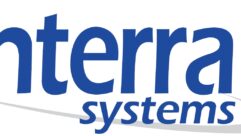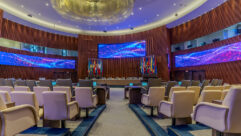
Technology Showcase: Conference-room Telephone Systems
Apr 1, 2008 12:00 PM,
By Bennett Liles
Plain old telephone service gets a boost in conferencing functionality.

Cisco Unified IP Conference Station 7937G
Even with the wide variety of conference- microphone systems and videoconferencing equipment, the most familiar piece of hardware to be seen in conference rooms large and small sits front and center, right in the middle of the conference table — the telephone conferencing system. Across manufacturers, the triangular shape is typical, and the range of options and accessories available has lately flowered into an array of new widgets offering vastly expanded functionality deserving of the “system” designation. USB connectivity to PCs extends functionality for VoIP, and ISDN ports allow direct digital functionality. External microphones can increase coverage area, and some units can be daisy-chained in a virtually unlimited number. The prices of these systems can range from less than $200 to more than $1,000.
THE FIELD
The Voice conferencing telephone system from Aethra offers analog and digital PBX compatibility, and the main unit comes in eight attractive colors. The main unit has three integral microphones, and it can accommodate two additional cable-connected microphones for larger groups or rooms with L-shaped or T-shaped conference tables. The Voice provides hands-free, full-duplex operation for natural-sounding conversation over a wide range of volume settings from +12dB to -12dB. The dial pad features a menu, a mute button, secondary functions, and a built-in phonebook for storing up to 100 numbers. Also featured are adaptive acoustic and line-echo cancellation, automatic gain control, and noise reduction, along with a line-level auxiliary output connector to record conferences. The unit is available in three versions: The standard configuration runs on PSTN connections; the Voice Plus includes the display and an infrared remote control; and the Voice ISDN works on an ISDN phone line and includes an RS-232 data port. The Voice can be used as an IP phone using the PC Audio Adapter that connects to a computer in the same way a headset would connect. The Voice also has a ringer-tone switch and pulse- or tone-dialing-mode selector. It features software-controlled room-noise and telephone-line-noise monitors. The Voice is available for less than $500.
The Avaya 4690 IP conference telephone provides the standard features of the Avaya line — including 360-degree room coverage, two optional extension microphones to cover rooms measuring up to 20’×30′, full-duplex operation, and a digitally tuned loudspeaker with Acoustic Clarity Technology to reduce reiteration requests. It adds simplified LAN wiring on a 10/100 Ethernet port and downloadable software upgrades for the Communication Manager IP telephony application. The unit has a five-line, 248×68-pixel LCD with variable-width fonts, three soft keys for access to common functions such as call transfer, red and green call-status LEDs, menu-navigation keys, mute and volume-control keys, and a hook switch for answering and terminating calls. Among the personalization features are five customizable ring patterns and 15 display-contrast settings. System information can also be displayed on the LCD. Ringer tones signify call forwarding, busy, call-waiting ringback, and other operations. Ethernet-connectivity features include auto-negotiation, 802.3 flow control, support for SNMP version 2, DHCP, and static IP addressing, along with G.711 and G.729A voice coders.
Technology Showcase: Conference-room Telephone Systems
Apr 1, 2008 12:00 PM,
By Bennett Liles
Plain old telephone service gets a boost in conferencing functionality.

Bogen V-Hub
The V-Hub conference phone from Bogen provides
full-duplex conversation ability through a large central loudspeaker
and three integral microphones placed at 120-degree intervals, using
DSP-based echo cancellation. Three green LEDs flash when the muting is
activated or when there is an incoming call, and they remain active
during the call. The controls include mute and flash buttons; on/off;
speed dial with a 10-number memory; and an LCD display screen that
shows call status, phone number dialed, ringing, and volume level. The
bottom of the unit holds a ringer-volume-selector switch, a wire
routing channel, and an integrated power and telephone-line connector.
The cables supplied includes the power line, a phone line, and an RCA
connector for recording conferences with external recording equipment.
The V-Hub can be found for less than $300.
A follow-on and upgrade product to the Cisco Unified
IP Conference Station 7936, the 7937G carries many teleconferencing
features backed by well-established Cisco voice-communication
technology. The G.722 codec enables wideband acoustic frequency
response. Power options include IEEE 802.3af power over Ethernet (PoE)
or the Cisco Power Cube 3. This also requires the use of the 7937G
Power Splitter. The external microphones have the same triangular form
factor as the main unit, and they provide extended coverage for
conference rooms up to 30’×40′. There is also support for a third-party
wireless lapel microphone for those needing increased mobility during
the conference. The backlit 255×128-pixel LCD has a 32-level grayscale
and a directories feature that allows you to easily navigate the menus
that categorize incoming calls and allow instant dial-back. The
settings key provides a selection of background images, ringer sounds,
and adjustments. Configuration can be manually or automatically set up
for dynamic host configuration protocol (DHCP) or trivial file transfer
protocol (TFTP) and the Cisco Unified Communications Manager. Users can
also access stocks, weather, quote of the day, and other web-based
information. The unit also offers a comprehensive online help feature.
With its advanced features, the 7937G system retails for around $1,000.
For conference rooms with up to eight people, ClearOne Systems
offers the Max Wireless, which eliminates wiring and provides mobility
and adaptability among conference rooms. The unit has distributed echo
cancellation, dynamic noise cancellation, and automatic level control
that adjusts to the incoming audio level. The first-mic priority
feature selects from the three microphones and activates the one
closest to the person speaking to prevent any hollow-room effect.
Wireless communication is secure through the use of 64-bit encrypted
communication on digital spread-spectrum technology in the 2.4GHz band.
The base unit connects to a power source and a phone line for a
transmission distance up to 150ft., which allows the phone to be picked
up and moved to any nearby conference room. The tabletop telephone unit
has a 12-hour battery life to accommodate long conversations without
worrying about losing power, and the dual-function power supply allows
conferencing while it is charging. When the battery is low or the phone
is out of range of the base unit, an audible warning will sound and a
paging button on the base unit will locate the telephone. The base
unit, with in-use and power LEDs, also has a recording output with a
2.5mm mini jack for external recording equipment. Features include a
10-number speed-dial memory, ringer switch, and manual
loudspeaker-volume control. The phone may also be used through a
digital adapter for operation on a digital PBX.
For small-and-medium-sized conference rooms, Cortelco
offers the CONF410PAK full-duplex conference telephone with RJ-11 PSTN
connections. The unit’s features include an on/off button with LED
indicator, a flash button, a mute button with LED, a redial button,
volume controls, pulse and tone dialing, and a three-position
ringer-level switch. An optional extension microphone, the CONF410MIC,
is available to add greater pickup to a larger conference area. This
will pick up conversation from 6ft. or less. A standard handset may be
connected to the unit for private conversations, and the conference can
be transferred to the handset at any time. Included with the telephone
unit are an AC adapter, a phone cord with RJ-11 connectors, and a user
guide. The CONF410PAK can be purchased for less than $150.
Technology Showcase: Conference-room Telephone Systems
Apr 1, 2008 12:00 PM,
By Bennett Liles
Plain old telephone service gets a boost in conferencing functionality.

Konftel 300
The Konftel 300 conference telephone can be connected
to standard PSTN circuits, be connected to wireless DECT/GSM telephones or computers, be switched between multiparty calls, and record calls on
an SD memory card. Expansion microphones (to increase coverage by up to
750 square feet), headsets, or even a PA system may be connected. The
unit uses patented OmniSound 2 technology in an ultrasensitive,
omnidirectional microphone and three built-in surround loudspeakers
with noise suppression and 7kHz wideband transmission. Individual
contacts may be saved in the integrated phonebook, and the conference
guide saves up to 20 groups with as many as six numbers each for rapid
conference setup. The unit allows calls to be switched and combined
between analog lines, mobile phones, and PCs for VoIP through a USB
port. Downloadable software upgrades are also available. When connected
to a PC, the unit can be used with Skype or other Internet
conference-calling programs. In standby mode, it can be used to play
music or other audio. The Konftel 300 also offers a security lock port
and a display on which menus can be navigated for feature menu setup
and operation. Setup menus enable selection of parameters such as ring
selection, equalizer, mobile level, screen text, time and date, contact
and group setup, recording, and language selection. The Konftel 300
lists for around $750.
The LifeSize high-definition audio-conference phone
uses 16 microphones in a patent-pending circular array to provide
complete room coverage, and it is equipped with electronic shielding to
eliminate the buzz frequently associated with cellular telephones and
PDAs. The unit uses MPEG-4 AAC audio and a special titanium loudspeaker
driver to provide frequency response up to 16kHz along with speaker
detection and echo cancellation. With the company’s LifeSize Room and
LifeSize Team, the phone can be integrated into a complete
videoconferencing application. The phone can connect simultaneously in
VoIP on standard SIP, H.323 IP PBX, or IP service and PSTN, running
either by PoE or through a PSTN adapter. A 240×64-pixel monochromatic
LCD display shows mute, volume control, and other programming and
control options. System management and maintenance may be handled
through an IP connection using LifeSize Control management software.
Technology Showcase: Conference-room Telephone Systems
Apr 1, 2008 12:00 PM,
By Bennett Liles
Plain old telephone service gets a boost in conferencing functionality.

NEC ConferenceMax
The NEC ConferenceMax provides full-duplex
communication for the smallest to the largest conference areas through
its expandable daisy-chain configurability for up to four ConferenceMax
units — putting loudspeakers, microphones, and control within easy
reach. Multiple units can work as one with distributed echo
cancellation, noise cancellation, first-mic priority, and automatic
gain and level control. The base unit connects to a standard RJ-11 wall
terminal and power outlet, and a Cat-5 cable is run to the Link In
terminal on the telephone unit, which houses the dial pad, volume
controls, and mute button along with an LCD display for menu setup and
features navigation. Each unit has three microphones for 360-degree
pickup.
The KX-TS730 conference recording speakerphone system from Panasonic
connects to a standard PSTN line through an adapter for full-duplex
calling, and it has a microphone on each of its four corners for
omnidirectional pickup in rooms measuring up to 360 square feet.
Features include automatic microphone selection and a digital echo
canceler for good pickup at distances up to 10ft. The backlit LCD
display works with three function keys for 120 minutes of recording and
playback, menu navigation, and the phonebook. The controls include
pulse- and tone-dialing selection, mute, four ringer levels, a flash
button for special service features, chain dial for calling while
conferencing, and display-flash time adjustment. There is a 16-step
digital volume control, 3.5mm audio-out jack for an external recording
device, 50-number call waiting/caller ID memory, 10-number history
redial, green and red line-status indicator LEDs, and six selectable
ringer patterns. Message function includes new and all-message playback
with skip and repeat. The KX-TS730 can be purchased for less than $350.
Fully Bluetooth-compatible with mobile phones and PCs, the Conference from Parrot
provides full-duplex conversation and echo cancellation. Centered on
the unit is an attractive 160×128-pixel TFT screen with 262,144 colors
that displays phonebooks, contact numbers, and their identifiers. The
user interface includes a 12-button keypad with on/off, call reject,
menu navigation, public and private phonebook management with up to
6,000 contacts, volume control, speed dialing, and a soft-touch control
knob. The unit features an integrated Skype interface, three
micro-phones for 360-degree pickup to a distance of up to 10ft., and a
5W hi-fi loudspeaker. Three high-capacity NiMH batteries provide power
for up to 10 hours with a 4-hour recharge time. The phone can operate
in normal, standby, or power-save mode.
Phoenix Audio markets the Quattro tabletop conference phone with
VoIP, PSTN, SIP, and connectivity for video codecs and Bluetooth. The
small unit has four loudspeakers; digital processing, including five
echo cancellers; beam-forming microphone algorithms; voice-activity
detectors; dereverb; and automatic gain control. The Quattro adjusts
the combination of microphones to favor the direction of the person
speaking and minimize background noise. On networks that can accept it,
the unit can provide frequency response from 20Hz to 20kHz. For VoIP
application, the unit connects directly to a computer through a USB
port, and it provides an audio sampling rate up to 44kHz. It can also
connect to a one- or two-line PSTN terminal with the internal PSTN
interface module and link up a conference between the computer, the
conference-room unit, and the PSTN line. For larger conference rooms,
multiple Quattro units can be daisy-chained to cover the wider area.
The various connectivity options can be ordered and installed
internally for a more convenient and compact appearance. When the unit
is connected to a PC, the downloadable audio-setup utility will
automatically adjust the audio volume to preset levels — which can be
adjusted by clicking and dragging the displayed screen icons. With the
USB interface only, the Quattro can be bought for less than $500.
The Polycom SoundStation VTX 1000 uses full-duplex
connectivity on a PSTN or analog PBX, and it allows clear pickup of
voices up to 20ft. away. When there is a VTX 1000 on each end of the
line, the units automatically connect in VTX Wideband mode to provide a
frequency response from 80Hz to 7kHz. Software upgrades can be
downloaded right into the phone on an ordinary PSTN line along with
selectable, downloadable ring tones. Automatic mic selection uses only
one microphone at a time, and they work with the dynamic
noise-reduction feature to automatically adapt to the particular room
acoustics. A subwoofer can provide bass response down to 80Hz, and the
two included extension microphones can provide even greater coverage
for larger rooms. Treble and bass controls can add or subtract within a
6dB range. The RCA audio input jack can be soft-key programmed to work
with a Polycom wireless microphone, an external audio source, or switch
off. The RCA output jack can be programmed to function for subwoofer,
PA connection, record-out, or off. With some shopping, the VTX 1000
system can be purchased for less than $900.
The 25001RE2 conference phone from RCA features three
micro-phones for 360-degree pickup in full-duplex conversation; a
backlit LCD display with adjustable contrast and a 100-name directory;
seven-level volume control; three-level ringer control; a data port for
parallel operation of a phone, fax, modem, or answerer; and one-touch
redial. Features also offered are a mute button, a call timer, and
all-station page. Prices for the unit start from as little as $167.
The Spracht CP 2012 conference phone has full-duplex
communication capability to provide natural-sounding conversation
without clipping speech, PBX compatibility, 360-degree pickup coverage
from four internal microphones, and expandability to include two
additional microphones for larger groups or irregularly shaped
conference areas. With the optional Voice Center DT-104 digital
adapter, the CP 2012 can connect to multi-line phones and a digital PBX
system. The unit also includes an RCA output jack for recording
conferences. On the AT-103 analog interface, the power and analog phone
connection are supplied through an RJ-45 connection and cable to the
unit, and the analog and digital interfaces may be either tabletop or
wall-mounted. On the phone, pulse or tone dialing is selectable, and a
standard analog handset may be connected to the unit for private
conversations. Calls may be easily transferred between the conferencing
system and the handset. In addition to the standard 12-button keypad,
the CP 2012 includes an on/off button; a flash button for accessing
special telephone-company services including three-way calling, redial,
and volume controls; and a mute key that turns off all microphones. The
CP 2012 retails for $250.
FOR MORE INFORMATION
Aethra
www.aethra.com
Avaya
www.avaya.com
Bogen
www.bogen.com
Cisco Systems
www.cisco.com
ClearOne
www.clearone.com
Cortelco
www.cortelco.com
Konftel
www.konftel.com
LifeSize Communications
www.lifesize.com
Panasonic
www.panasonic.com
Parrot
www.parrot.com/usa
Phoenix Audio Technologies
www.phoenixaudio.com
Polycom
www.polycom.com
Spracht
www.spracht.com










